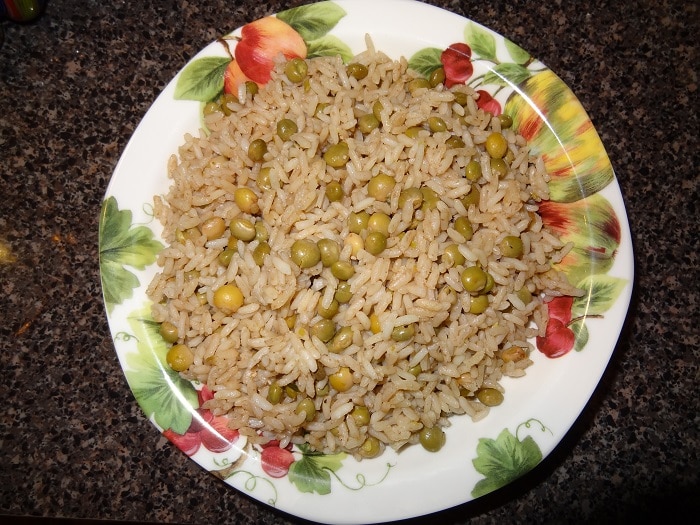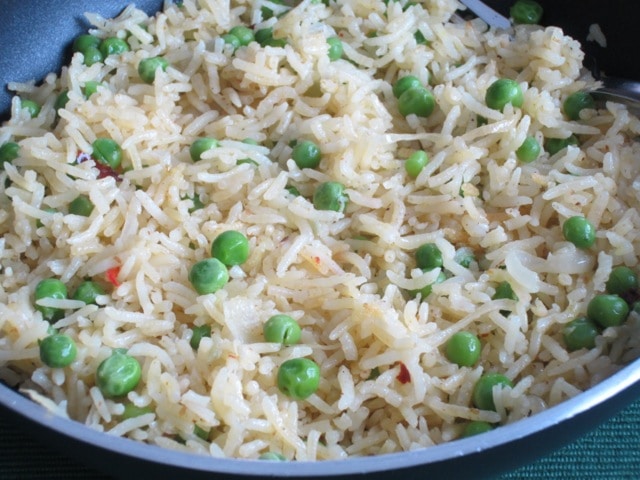Fragrant Jamaican coconut rice is the perfect complement to jerk chicken and curried meats. When prepared simply with coconut cream and butter, the side dish helps extinguish some of the heat from the bold spices in Jamaican main dishes. Coconut rice with peas is a more heavily seasoned version of the dish and is the centerpiece of Jamaican Sunday dinner.
With peas or without, Jamaican coconut rice is the quintessential comfort food of Caribbean cooking. Read on to learn the history and cultural significance of Jamaican coconut rice, as well as two recipes for cooking this tasty side dish.
The Multi-Cultural History of Jamaican Coconut Rice
When West Africans from the Ivory Coast and Ghana arrived in Jamaica, they faced a grueling new life as slaves. They also missed their beloved customs and culture. Many slaves clung to old family recipes, especially the comforting rice and pea dishes from their homeland. One of the most popular versions of Jamaican coconut rice and peas actually uses kidney beans, which Jamaicans call red peas. Pigeon peas, known as gungo peas in Jamaica, are also popular around Christmastime when fresh gungo peas are in season.
Influenced by the tropical climate of the Caribbean, Jamaican slaves began to enrich their rice with fragrant coconut cream. In the 1700s, this was a laborious process. They scraped the dried coconut meat from the hard shell, shredded it, and squeezed it through a sieve to extract the rich cream. Today, with canned coconut cream widely available, Jamaican coconut rice is a much simpler dish to prepare.
For many Jamaicans, Sunday wouldn’t be Sunday without their rice and peas. This tradition goes back to the days of slavery. Because Sunday was the only day off from their intense labor, it was also the day they served their most treasured foods to remind them of home. These days, Jamaican coconut rice and peas can easily claim the title of Jamaica’s most popular dish. It’s a common dish every day of the week as well as at festivals, holidays and celebrations. It’s also standard fare on the menus at Jamaican restaurants.
How to Prepare Jamaican Coconut Rice at Home
Coconut rice can be prepared as a simple side or as a slightly more elaborate dish with beans and aromatic spices. Coconut rice makes a great accompaniment to spicy Jamaican jerk dishes. Jamaican coconut rice and peas is a heartier version that provides a complete protein. We offer both versions below.
Simple Jamaican Coconut Rice
- 2 cups basmati (or long-grain) rice.
- 1 cup water.
- 2 Tbs butter.
- 1 cup coconut cream.
- 1 Tbs salt or to taste.
Instructions:
- First, rinse the rice with water until the liquid is no longer cloudy. Washing away the excess starch will prevent the rice from sticking together in clumps. Basmati rice will give this dish the fluffiest, most tender texture and will cook quickly, but you can substitute long-grain rice if you can’t find basmati.
- Next, bring 1 cup of water to boil in a large pot on medium high heat.
- Add the rice and reduce to medium heat.
- Add the coconut milk, salt and butter and stir ingredients together.
- Cover the pot and cook for about twenty minutes or until all the liquid has been absorbed. It’s best not to lift the lid until the rice is done. Use a pot with a glass lid to help you determine when the water has been fully absorbed.
- Remove the lid and briefly fluff the rice with a fork.
- Serve immediately alongside jerk chicken, curried meats, fried fish and crisp Jamaican slaw for a traditional meal.
Traditional Jamaican Coconut Rice and Peas

- 2 cups long-grain rice.
- 2 cups water.
- 1 can kidney beans, pigeon peas or black-eyed peas, drained with liquid reserved.
- 1 can coconut milk.
- 3 cloves garlic, minced.
- 1 small onion, diced.
- ½ tsp dried ginger powder.
- 1 tsp dried or 2 tsp fresh thyme leaves.
- 1 Scotch bonnet pepper (optional).
- 2 Tbs vegetable oil.
- Salt and pepper to taste.
- 1 tsp allspice.
Instructions:
- Saute the onion in a saucepan over medium heat until it is fragrant and translucent. Add the minced garlic and cook for a few more minutes, taking care not to burn it.
- Add the ginger, thyme, allspice and pepper if desired, and cook a minute more to bring out the aroma of the spices.
- While the aromatics are cooking, rinse your rice until the water runs clear.
- Add two cups water, the coconut milk and the liquid from the canned beans to the pot with the aromatics and spices. Bring to a boil.
- Add the rice and drained beans to the pot and stir briefly to incorporate. When the mixture boils again, cover the pot and cook for about 20 minutes until all the liquid is absorbed. Again, a pot with a clear lid can be helpful for seeing when the rice has finished cooking without releasing the hot steam prematurely.
- Remove the rice from the heat and transfer to a large bowl or serving platter, removing the Scotch bonnet. Season with salt, black pepper, and fresh thyme leaves if desired.
Where Can You Try Jamaican Coconut Rice in a Restaurant?
Nicknamed Jamaica’s “Coat of Arms,” the dish is foundational to any Jamaican restaurant menu. If you’re looking for an authentic experience stateside, consider trying Chelly’s Jamaican Restaurant in Sunrise, Florida. Ms. Chelly herself will serve you up some luscious and tender rice and peas. Fans of the restaurant rave about how the side dish readily absorbs the sauces from main dish meat stews.
In Jamaica, you’ll be hard-pressed to find a Caribbean restaurant without coconut rice and beans on the menu. For a special treat, visit the critically-acclaimed Just Natural in Negril. In addition to excellent Jamaican coconut rice and peas, Just Natural boasts a garden setting.
Regardless of whether you are able to visit an authentic Jamaican restaurant or not, Jamaican coconut rice is worth the easy effort it takes to enjoy it at home. Try this exotic yet comforting side dish, and you’ll begin to understand its modern popularity as well as its long, multi-cultural history.
If you’ve tried out the recipes above or have your own special version of coconut rice and peas, we’d love to hear about it in the comment section below!

